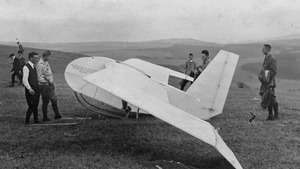Akaflieg Berlin B1
The Akaflieg Berlin B1 Charlotte (named after the University at Charlottenburg), was a glider built in Germany in the 1920s. It featured a high-wing, tailless sailplane configuration of all-wood construction, which had a pair of skids for landing.[1]
| B1 Charlotte | |
|---|---|
 | |
| Charlotte at the Rhön competition in 1922 | |
| Role | Sailplane |
| National origin | Germany |
| Manufacturer | Akaflieg Berlin |
| Number built | 1 |
Design and development
Hermann Winter and Edmund Pfister shared the design work for the "Charlotte", hoping to compete at the 2nd Rhön competition at the Wasserkuppe. Progress was slow as Pfister had a full time job to fulfill. Professor Winter was determined to compete at the next Rhön meeting, so he engaged the Sablatnig Works for completion of the glider, which went on to win at the Wasserkuppe in August 1922.[2]
Specifications (B 1)
Data from 75 Jahre 10 NI AKAFLIEG BERLIN 1920 - 1995[2]
General characteristics
- Crew: 1
- Length: 4.5 m (14 ft 9 in)
- Wingspan: 15.2 m (49 ft 10 in)
- Wing area: 20 m2 (220 sq ft)
- Aspect ratio: 11.1
- Empty weight: 100 kg (220 lb)
- Gross weight: 170 kg (375 lb)
Performance
- Wing loading: 8.5 kg/m2 (1.7 lb/sq ft)
gollark: Probably not very, English is hard.
gollark: There's a Python NLP library but I don't know how good it is.
gollark: Huh, I've beaten SquidDev?
gollark: What do you run on there?
gollark: My hosting costs probably £5/month in power and about that much (maybe) in amortized server hardware cost.
References
- Winter, Hermann (1949). Segelflug und Langsamflug Neue Wege in der Sportfliegerei (in German). Braunschweig: Gustav Wenzel & Sohn. p. 23-28.
- Wefeld, Hans Joachim (1995). 75 Jahre 10 NI AKAFLIEG BERLIN 1920 - 1995 (in German). Akademische Fliegergruppe Berlin e.V. pp. 12–14, 20.
This article is issued from Wikipedia. The text is licensed under Creative Commons - Attribution - Sharealike. Additional terms may apply for the media files.